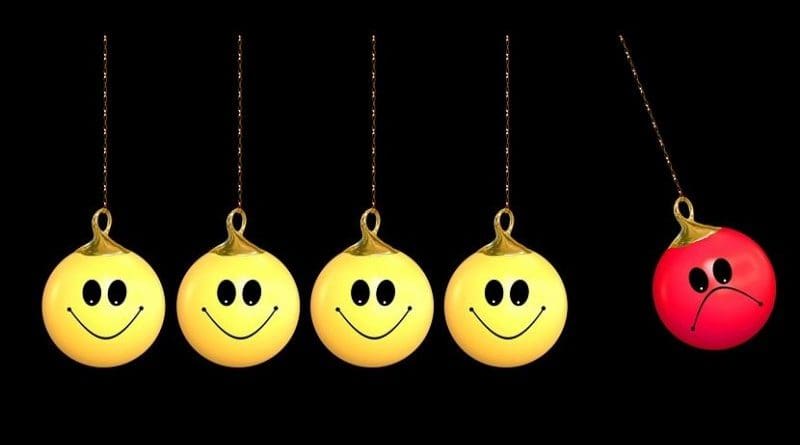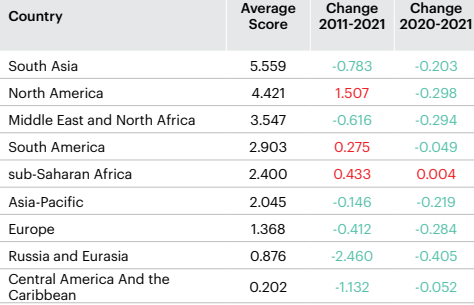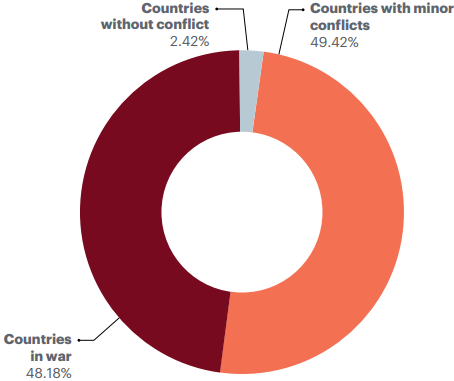Russia And Eurasia: Can The Region Sustain Its Declining Terrorism Trend? – Analysis
By Observer Research Foundation
By Aditya Bhan
In the fourth meeting of the India-Tajikistan Joint Working Group on Counter-Terrorism held on 13 September 2022, the two countries expressed strong condemnation of terrorism in all its forms and rejected the double standards in countering terrorism and extremism conducive to terrorism. The Global Terrorism Index (GTI) 2022 report reveals that India fares far worse as a victim of terrorism than Tajikistan, with a GTI-based rank of 12 versus Tajikistan’s 47, just as South Asia faces much higher terrorist violence at the regional level as compared to Russia and Eurasia.
In fact, South Asia is the region with the highest average score on the GTI since 2007. On the other hand, Russia and Eurasia recorded the largest improvement in 2021 (see Table 1), with the region recording a 71-percent decline in terror-related deaths. Furthermore, the number of people killed in terror strikes has declined every year over the past four years in the latter region and has fallen by 99 percent from the peak of 317 deaths in 2010. With multiple armed conflicts ravaging different parts of the region in recent times and the significant linkages between armed conflict and terrorism, a question mark hangs on the ability of Russia and Eurasia to sustain its declining trend in terrorist violence.
Table 1: GTI score, rank, and change in score
Terrorism and conflict
There is a strong link between conflict and terrorism because as conflict intensifies, attacks targeting police and military gain legitimacy, as do those targeting civilians connected with the adversary such as sympathisers and over-ground workers (OGW). Armed conflict may also provide easy access to weapons, particularly small arms, and lesser state authority over the territory. Further, as conflict intensifies, psychological hurdles against large-scale violence diminish.
Terrorism seems to be withdrawing into conflict zones, with a higher percentage of terror strikes occurring in conflict areas. Nearly 95.8 percent of terrorism-related deaths happened in conflict-affected countries over the last three years, which rose to 97.6 percent in 2021 (see Figure 1).
Figure 1: Percentage of deaths by conflict type in 2021
Notably, both the lethality and frequency of terror strikes increase as the conflict becomes more intense. In particular, terror strikes in conflict-affected countries are six times as deadly as those in countries without conflict, and there is a 10-percent rise in the annual number of terror attacks related to a 4.7-percent increase in the count of annual battle demises.
A war-torn region
With the Russia-Ukraine war showing no signs of ending, outfits like al-Qaeda and the Islamic State may take advantage of the vulnerabilities created by Russian military deployments on the Ukrainian front. Further, Caucasian Islamist groups could exploit the Russian diversion in Ukraine to reactivate, regroup, and attack.
Jihadist organisations have recruited in the thousands from Russia (mainly North Caucasus) and former Soviet states over the last decade, with about 5000from only Chechnya and Dagestan and approximately 6,000from Central Asia, particularly Kazakhstan, Kyrgyzstan, Tajikistan, and Uzbekistan. As the Russia-Ukraine war escalates, these groups could also look to radicalise and recruit from amongst the one million Muslim Tatars in Ukraine, and utilise them to attack Russian targets in Ukraine itself.
To make matters worse, the recently aggravated but decades-old Nagorno-Karabakh conflict between Armenia and Azerbaijan is already attracting foreign mercenaries into the region, with reports of Turkish groups and terror outfits fighting on the Azerbaijani side. Forebodingly, Russian President Vladimir Putin had stated as early as in December 2020 that hostilities in Nagorno-Karabakh have “unfortunately led to numerous human casualties, exacerbated the already difficult situation in the South Caucasus, and increased the risks of the spread of the terrorist threat”, and those fears appear to be materialising.
In addition to the conflicts, violent clashes involving tanks, mortars, rocket artillery, and assault drones also recently broke out along the highly militarised Kyrgyzstan-Tajikistan border, claiming the lives of at least 110 people and displacing thousands. Although a tenuous ceasefire has been agreed upon through Russian mediation, both sides have accused each other of violating the truce. And with an uncanny resemblance to the gory conflict that occurred in the same region in April 2021, the latest flare-up joins the disturbing trend of regular, large-scale, and intense international military conflicts that endanger tranquillity and stability in Central Asia, providing a fertile environment for radicalisation and terrorism.
Outlook
Given that the GTI 2022 report identifies a change in terrorism dynamics and that such activities are more concentrated in politically unstable and conflict-ridden regions and countries, Russia and Eurasia is, therefore, vulnerable, notwithstanding the steep decline in terror-related casualties in particular and terrorist activity in general, witnessed in the region over the last few years. Concerted efforts aimed at curtailing violent conflict and maintaining political stability are the need of the hour. In their absence, there exists a material risk of a revival in recruitment prospects for radical outfits seeking to exploit existing fault lines within the region. The resulting extremism may then begin to erode the recent gains achieved on the terrorism front.
Views expressed are personal.



